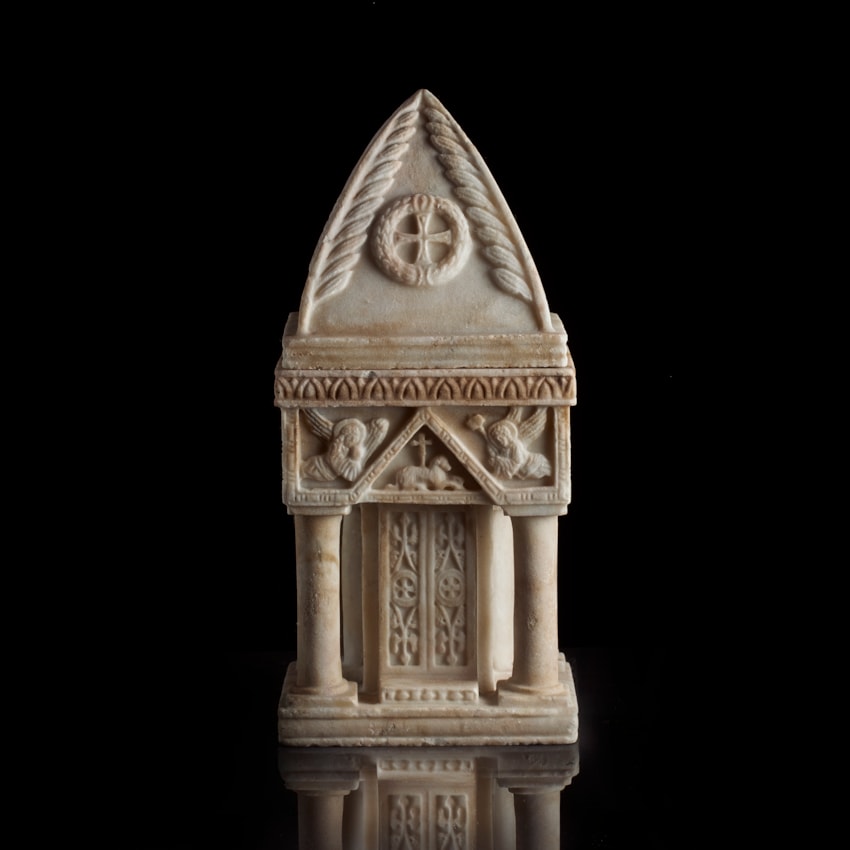18782

A Byzantine church shaped ciborium
A Byzantine church shaped ciborium

A Byzantine church shaped ciborium
31.5 x 14.5 x 14.5 cm (12 ³/₈ x 5 ³/₄ x 5 ³/₄ inches)
Marble
6th century AD
phone 0032 3 314 90 34 – mobile 0032476 963 483.
PROVENANCE
Private collection UK, formerly acquired on the UK art market in the early 1980s.
ADDITIONAL PICTURES







READ
FULL DESCRIPTION
This lidded marble reliquary casket has the shape of a Church ciborium ("ciborion"- Kißoprovin Greek) squared in plan. The church and lid have been carved separately, each from a single piece of marble.
The lid is composed by a pyramid cornered on four sides by branches of palm, flanking on three sides a central Greek cross closed within a laurel wreath. At the front, the laurel wreath surrounds the Christian monogram Chi-Ro.
The body of the reliquary is composed by four arcaded outer faces, each supported by four small columns, and a central pilaster with columns incorporated, on three sides, the space over them creating a niche shaped like a shell.
On the frontal side the space of the pilaster is sculpted like the door of a church, decorated with two crosses closed inside a circle. In the timphane above the doors we see the image of the Divine Lamb Agnus Dei flanked by the archangels Michael and Gabriel. The top is edged with a decorated band.
The various friezes with floral motifs and crosses are carved in deep relief. The carvings are partly undercut in many places to give a three-dimensional effect. Creating the four pillars from a solid block of marble requires considerable skill. Their relative uniformity attests to the expertise of the carver. The central square pillar also has pillars, undercut at the back for a three-dimensional effect.
The fine work of art shows decorations and characters typical of the Age of Justinian the Great (527-565 AD). The exquisite facture of the work points to Greek workshops of the Empire, in particular Thessaloniki or Constantinople.
This reliquary most probably belonged to a church, an Episcopal Palace or the private chapel of a worthy man, layman or ecclesiastical. The precious object, in its perfection and refinement of execution is rare and unique in its kind.
The lid is composed by a pyramid cornered on four sides by branches of palm, flanking on three sides a central Greek cross closed within a laurel wreath. At the front, the laurel wreath surrounds the Christian monogram Chi-Ro.
The body of the reliquary is composed by four arcaded outer faces, each supported by four small columns, and a central pilaster with columns incorporated, on three sides, the space over them creating a niche shaped like a shell.
On the frontal side the space of the pilaster is sculpted like the door of a church, decorated with two crosses closed inside a circle. In the timphane above the doors we see the image of the Divine Lamb Agnus Dei flanked by the archangels Michael and Gabriel. The top is edged with a decorated band.
The various friezes with floral motifs and crosses are carved in deep relief. The carvings are partly undercut in many places to give a three-dimensional effect. Creating the four pillars from a solid block of marble requires considerable skill. Their relative uniformity attests to the expertise of the carver. The central square pillar also has pillars, undercut at the back for a three-dimensional effect.
The fine work of art shows decorations and characters typical of the Age of Justinian the Great (527-565 AD). The exquisite facture of the work points to Greek workshops of the Empire, in particular Thessaloniki or Constantinople.
This reliquary most probably belonged to a church, an Episcopal Palace or the private chapel of a worthy man, layman or ecclesiastical. The precious object, in its perfection and refinement of execution is rare and unique in its kind.




